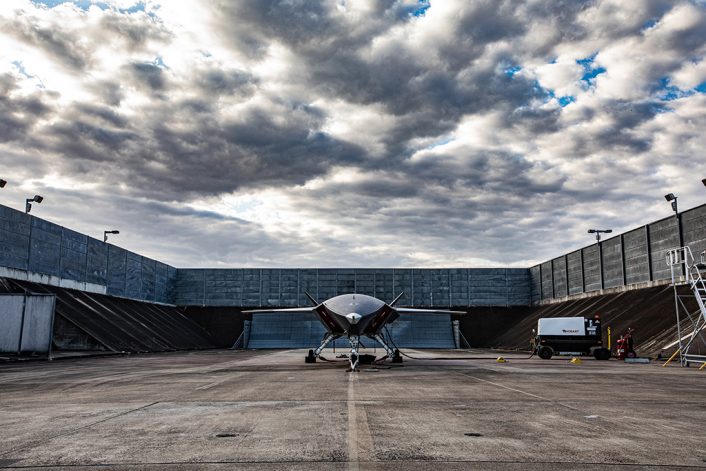Two new photos and a video have been released along with the news of the first engine run of the “artificial intelligence-powered teaming aircraft” for the Royal Australian Air Force.
Boeing Australia has just fired up the commercial turbofan engine on the first Loyal Wingman, as part of ground testing and preparations for first flight (planned before the end of the year), the company has announced on Sept. 14, 2020 (EST).
“This milestone comes on the heels of Boeing completing the first unmanned Loyal Wingman aircraft for the Royal Australian Air Force earlier this year, a major step forward for the unmanned vehicle serving as the foundation for the global Boeing Airpower Teaming System, an artificial intelligence-powered teaming aircraft developed for the global defense market,” says the official statement released by Boeing.
“This engine run gets us closer toward flying the first aircraft later this year and was successful thanks to the collaboration and dedication of our team,” said Dr. Shane Arnott, program director of the Boeing Airpower Teaming System. “We’ve been able to select a very light, off-the-shelf jet engine for the unmanned system as a result of the advanced manufacturing technologies applied to the aircraft.”
However, two new images of the Airpower Teaming System (ATS) unmanned aircraft, developed for the Loyal Wingman Advanced Development Program of the Royal Australian Air Force (RAAF) have been released alongside the pretty short official statement (one is the headline photo, the other one can be found here below).

Although Boeing has been tight-lipped and has provided no detail about the location where the first three aircraft are being built, the ATS was sighted in the open while undergoing ground testing in preparation for the taxi trials at an unspecified airfield in Queensland, a location that we believe could have been RAAF Base Amberley, some 40 km south-west of Brisbane, home of Boeing Australia.
Here are some details about the ATS included in the article on the program, written by Stefano D’Urso, we published few weeks ago:
As we wrote in occasion of the roll-out, this drone is the first clean-sheet design created by Boeing outside the United States and also the first RAAF’s clean-sheet design in more than 50 years. The project, which involved several Australian companies, used new development techniques, like the “digital twin” concept, and new automated production systems.
One of the key features of the ATS is an 8.5 ft (2.6 m) long modular nose cone with 9000 cubic inches internal volume to house different payloads, which can be entirely swapped quickly according to the mission’s needs.
A similar AI-based program, called Skyborg Vanguard Program, is also in development by the U.S. Air Force and the Air Force Research Laboratory (AFRL). Skyborg is described as “an autonomy-focused capability that will enable the Air Force to operate and sustain low-cost, teamed aircraft that can thwart adversaries with quick, decisive actions in contested environments.”
The system’s functioning looks similar to the Boeing ATS: “Military pilots receive key information about their surroundings when teamed aircraft with integrated autonomy detect potential air and ground threats, determine threat proximity, analyze imminent danger, and identify suitable options for striking or evading enemy aircraft. Embedded within the teamed aircraft, complex algorithms and cutting-edge sensors enable the autonomy to make decisions based on established rules of engagement set by manned teammates. Field tests will ensure the algorithms’ accuracy and verify that the system continuously operates within the constraints established during mission planning.”
For a quick comparison, the ATS will be flown by Artificial Intelligence (AI) and controlled from the back seat of a Super Hornet or a Growler for smaller formations, or from a control station aboard a Wedgetail or a Poseidon. Boeing didn’t provide details on how the AI specifically works, but explained that the controller will simply signal the mission intent to the Loyal Wingman and the AI will figure out by itself mission specifics and navigation, while keeping a safe separation from other manned and unmanned aircraft.
Boeing plans to submit a variant of ATS for Skyborg. Other companies competing in the program are Northrop Grumman, General Atomics and Kratos.